

|
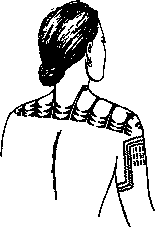
|
Tattooing in the Marshall IslandsThe Men's Tattoos |
In their entirety, Marshallese menĽs tattoes are very striking. As a number of authors have pointed out, a completely tattooed Marshallese man appears--at least for European eyes--to be dressed in a chainsuit, resembling a medieval knight. [136] A menĽs tattoo is laid out in a series of ornament zones which bear descriptive Marshallese names, such as "mast", "ocean" "swell", "boat", "clouds" and the like, all of which find their origin in the seafaring nature of Marshallese men.
With the exception of the tattoo of the face and the upper shoulders, which was the prerogative of the
There are a number of photographs available, mainly in black and white, but the tattoos stand out only in a few of them to such a degree that the tattoo patterns and ornament lay-out can be studied. [137] The mainstay of the documentation rests on the drawings reproduced by the early visitors and the German ethnographers.
Let us first have a look at the menĽs chest tattoos, then those on the back and finally at the other smaller tattoo areas, such as arms, legs, buttocks, face and so on.
Chest Tattooes
According to
"the artistically delicate tattooing. [i]n men. forms a triangle that encompasses shoulders and chest and comes to a point at the navel and consists of smaller, variously connected lines. Similarly wellÍordered horizontal lines frame the back and the abdomen." [139]
A complete menĽs chest tattoo consists of three main tattoo components, which can be added to. These main areas are the upper and the lower chest triangle as well as a central vertical ornament field (figure 24).
The upper chest triangle (
The lower chest triangle (
Both chest triangles are split into two halves by the central vertical ornament field (
Added to these three main components could be other ornament fields, such as a shoulder tattoo (see next section), a tattoo on the side of the chest or a stomach band. A tattoo on the side of the chest, between the arm and the torso, called

Figure 24 Lay-out of a manĽs chest tattoo
The area above the upper chest triangle can-optionally--be filled with a shoulder tattoo (
In addition, the upper part of the shoulder can be decorated (
Description of selected chest and shoulder tattoos
In the following a selection of complete men's chest and shoulder tattoo, which have been recorded in the past by means of photography or drawing, will be described. It should be kept in mind that the number of documented tattoos is very limited.
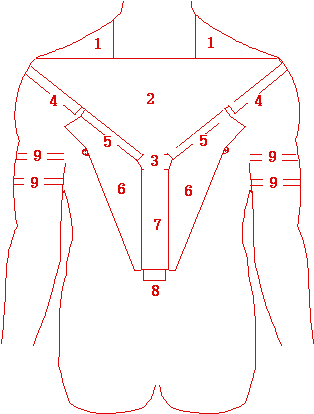
Young chief from Jaluit
The chest tattoo of a young chief from Jaluit Atoll (figure 26) [153] consists of three main components, menin leob, ittut and kiju, with an additional shoulder tattoo and arm tattoos. In total nine different ornament and sub-ornament zones can be identified (figure 25). The upper chest triangle is decorated with a horizontal bands of dots interspersed at regular intervals by oblique strokes (motif 26a). This zone is bordered by a double zigzag line towards the lower chest triangle. This double zigzagline is set in two groups, an upper group, which shows a single eo line (20a) and then a double set of proper kein k·m zigzag motifs (1), while the lower group utilises the pako motif (21a or 21b). The points of the pako triangles point downward.
The lower chest triangle has slightly indented sides, with the nipples as the turning points. The field is covered with oblique kein k·m zigzag (motif 1).
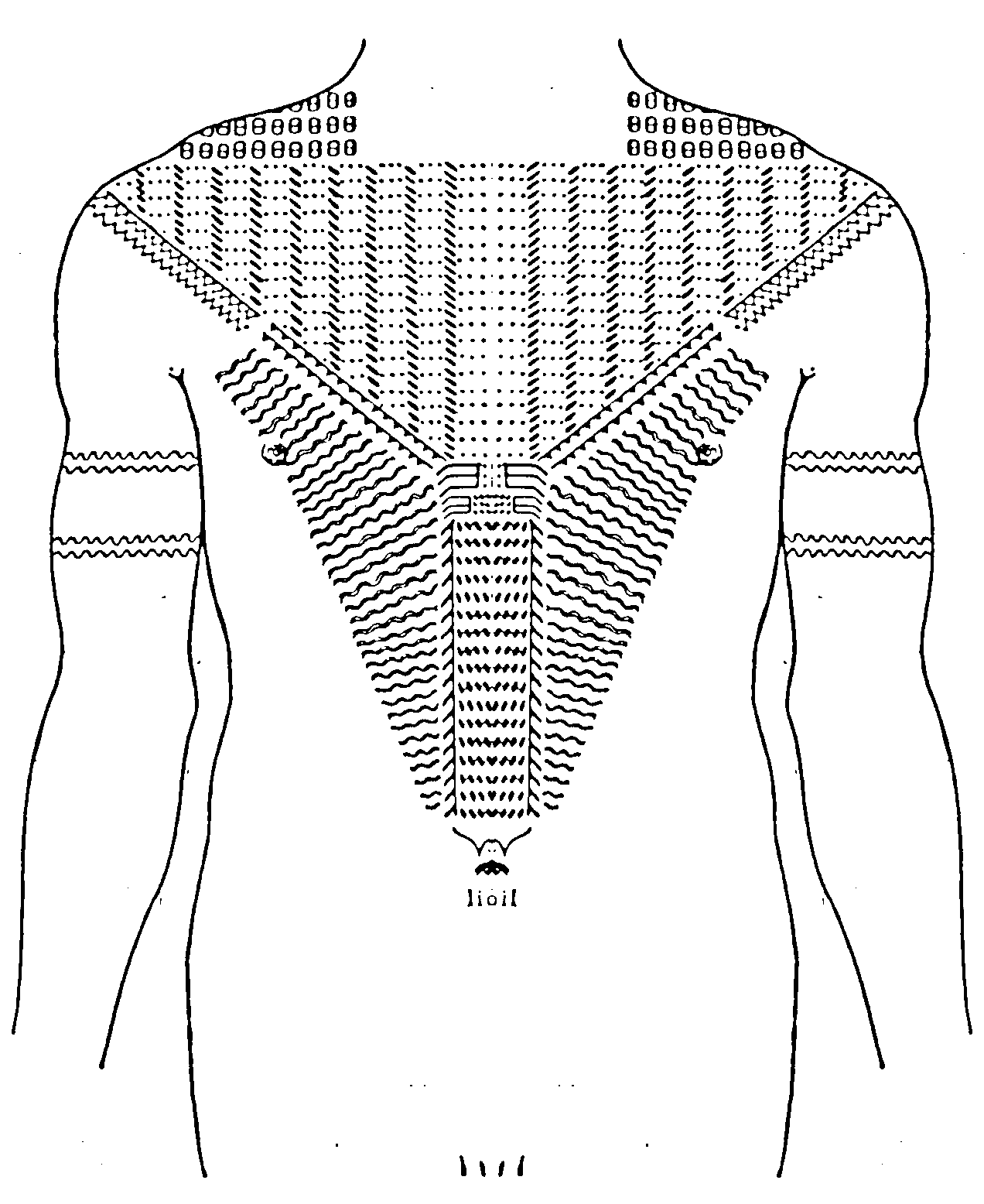
The central mast ornament field is well distinguishable from the upper chest triangle for the want of oblique strokes. At the junction of the upper chest triangle and the lower chest triangle the mast shows two pairs of three-pronged annijjar motifs (12b). The lower mast section consists of a series of oblique strokes, similar to those in the upper chest triangle, but without the interspersed dots (motif 26b). This lower mast section is bordered by either l·żjak(7) or pĽdĽlijmaan (8) motifs. The mast ends in a navel ornament, the dĽnnin w·t (18).
The shoulder sections, save for the throat area, are tattooed with rows of kilin b¨l motifs (17). The upper arms show two sets of doubble zigzag lines giving the appearance of bands worn on the arms. The frontal tattoo has all ornament fields save for the stomach band.
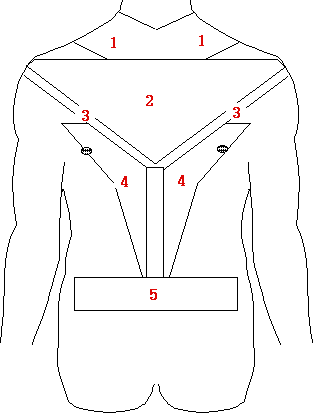
Young chief from Mile
The chest tattoo of a young chief from Mile Atoll (figure 28) shows all the components: it has an upper and a lower chest triangle, a mast, a stomach band and shoulder/neck tattoos. In total, nine different ornament and subornament zones could be identified (figure 27).
The upper chest triangle which is evenly covered with the kadikdik motif (23c), is well set out and reaches from the shoulder joint to the lower end of the sternale. The triangle is bordered both towards the shoulders and towards the lower chest triangle with continuous zigzag line (kein k·m 1). At the upper border only the throat area is spared. The border band towards the lower chest triangle is then split into two segments. On both sides the upper segment consists of two additional kein k·m lines, while the lower segment consists of a wide l·żjakmotif (7).
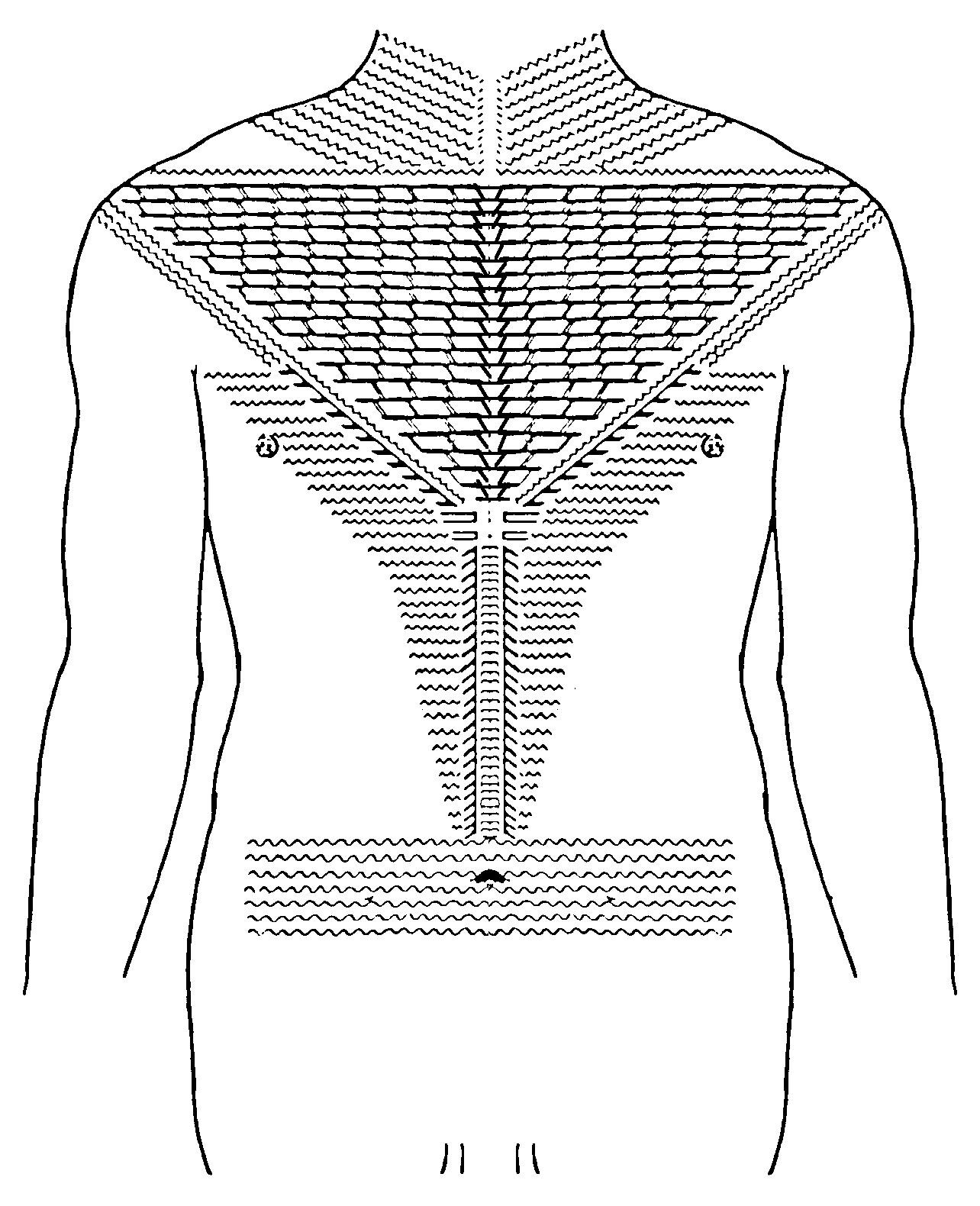
The lower chest triangle, which has indented sides with the turning points approximately at the lower rib area consists of horizontally aligned kein k·m zigzag lines (1). The central mast ornament field is not well distinguishable in the upper chest triangle. Only the change in the orientation of the offsets indicates a break in the ornament. Like the tattoo of the young Jaluit chief (figure 26) the chest tattoo of the Mile chief shows two pairs of three-pronged anijjar motifs (no12b) at the junction of the upper chest triangle and the lower chest triangle the mast. The lower mast section consists of a series of multi-pronged horizontal motif units, either looj (13) or addijokur (30). This lower mast section is bordered by either pĽdĽlijmaan (8) or, more likely, l·żjak(7) motifs. The mast ends in the stomach band. The rather narrow stomach band, which begins slightly above the navel, consists of horizontal k·do motifs (4a).
The neck tattoo reached from the shoulder zone to the lower border of the mandible and consists a series of oblique oriented zigzag lines (kein k·m?, 1), with the direct frontal area at the throat and AdamĽs apple spared. This vertical, tattoo free zone is bordered by a series of dots (ibeiro, 10b), aligned vertically to provide a clean border for the jagged zigzags.
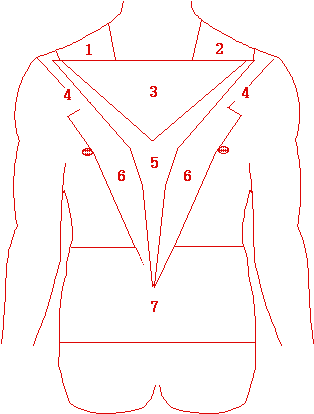
The chest tattoo of a commoner (kajur) from Mile Atoll (figure 30) shows all the components: it has an upper and a lower chest triangle, a mast, a stomach band and shoulder/neck tattoos. In total, seven different ornament and subornament zones could be identified (figure 29). Thus it is, on the whole, similar to the previous tattoos, yet in its details it differs substantially. For one, the shoulder and neck tattoo does not cover the neck as such, and the mast is not as well defined as in the two irooj tattoos described previously. Another major difference is the lack of the set of anijjar motifs in the mast at the point where upper chest triangle joins the mast.
In the tattoo, the upper chest triangle is composed of rows of interconnected, filled oblique ovals (lijja 3a) which are connected with vertical filled ovals (motif 3b). The chest triangle does not have a well defined border as the previous tattoos. Instead, a wide new ornament field is introduced consisting of sets of tokrak motifs (11). This field, which has an overall Y-shaped appearance, converges into a mast, where the tokrak motifs are arranged symmetrically. The mast runs out in a pointed fashion at the navel, where it is joined with the lower chest triangle.
The lower chest triangle is comprised of oblique oriented zigzag lines (kein k·m?, motif 1). At the area of the arm pits the new Y-shaped ornament field is bordered by two short zigzag lines (kein k·m) set at right angles to the previous zone. The sides of the triangle are slightly indented, the turning points being in the area of the nipples.
The quite broad stomach band begins well above the navel and reaches far down, apparently to the onset of the pubic triangle. The band, which is intersected by the pointed lower parts of the mast and lower chest triangle, consists of horizontal k·do motifs (4a).
The shoulder ornament, which keeps the entire neck and throat area free, shows two different tattooing motifs. The right shoulder is covered with vertically aligned rows of the elongwa motif (5), which in the applied orientation seems a set of wide-spaced zigzag lines with dots at the turning points, the B·d eo L·b·ll·ż motif (2).
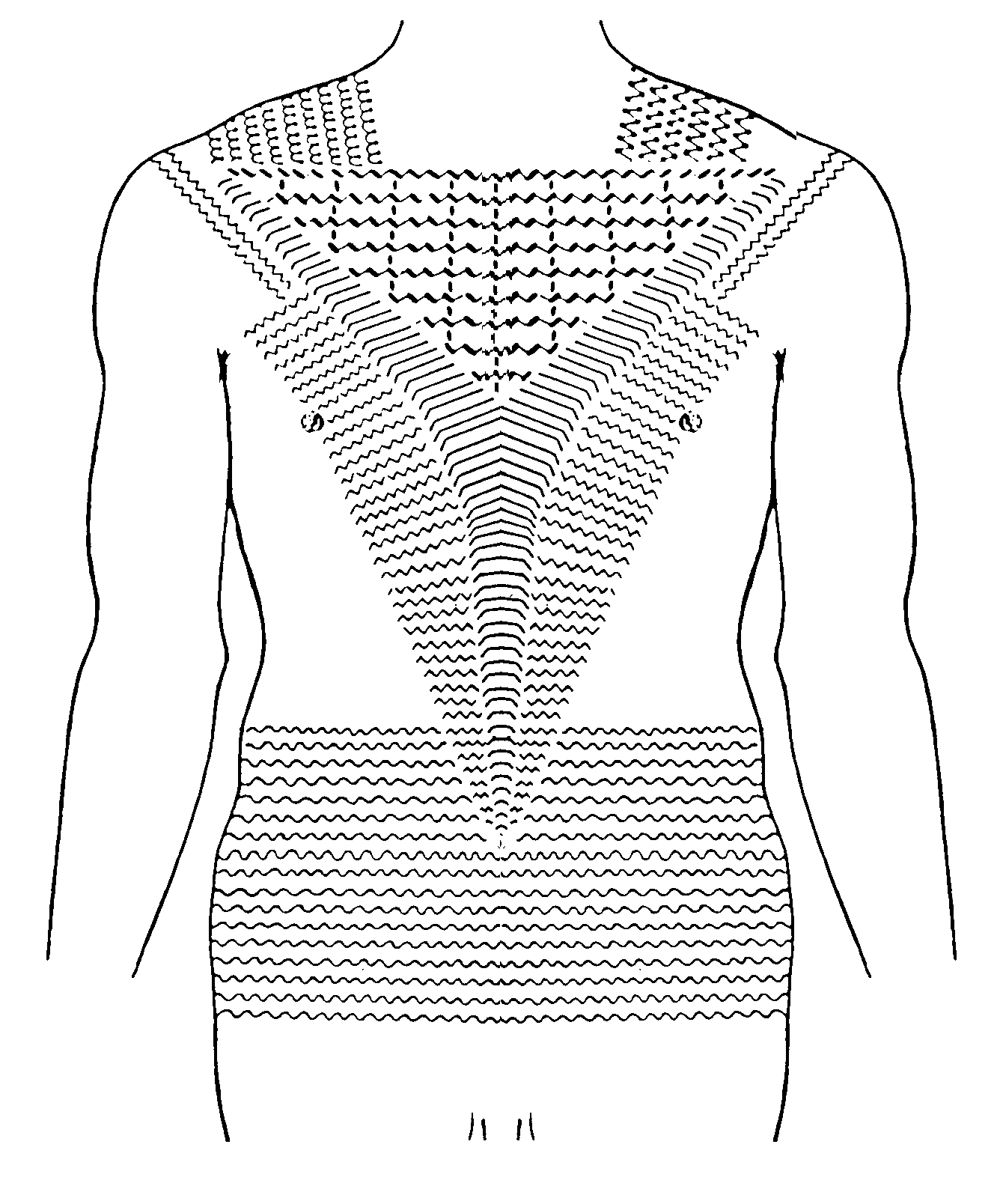
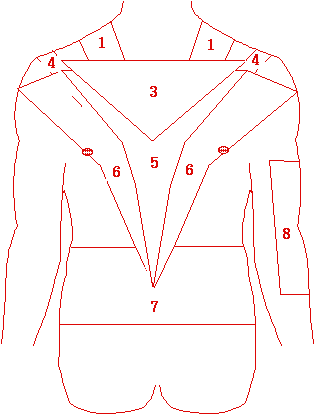
Another Young chief from Jaluit
The chest tattoo of a young chief from Jaluit Atoll (figure 32) is similar in lay-out to the previous tattoo. It too shows all the components: it has an upper and a lower chest triangle, a mast, a stomach band and shoulder/neck tattoos. Further, an area on the arm is tattooed. In total, eight different ornament and subornament zones could be identified (figure 31).
In the tattoo, the upper chest triangle is composed of rows of interconnected filled oblique ovals (lijja motif 3a) which are connected with vertical filled ovals (motif 3b). The chest triangle does not have well defined border as the first two tattoos. Instead a wide new ornament field is introduced consisting of sets of tokrak motifs (11). This field, which has an overall Y-shaped appearance, converges into a mast, where the tokrak motifs are arranged symmetrically. The mast runs out in a pointed fashion at the navel, where it is joined with the lower chest triangle.
The lower chest triangle is comprised of oblique oriented zigzag lines (kein k·m?, motif 1). At the area of the arm pits the new Y-shaped ornament field is bordered by four short zigzag lines (kein k·m) set at right angles to the previous zone. The shape of this triangle are fairly complex. It has a rather wide base, reaching well onto the upper arm, and uses the nipples as a turning point. It runs out in pointed fashion in the navel area.
The quite broad stomach band begins well above the navel and reaches far down, apparently to the onset of the pubic triangle. The band, which is intersected by the pointed lower parts of the mast and lower chest triangle, consists of horizontal k·do motifs (4a). The shoulder ornament, which keeps the entire neck and throat area free, shows two zones of oblique zigzags (kein k·m, 1).
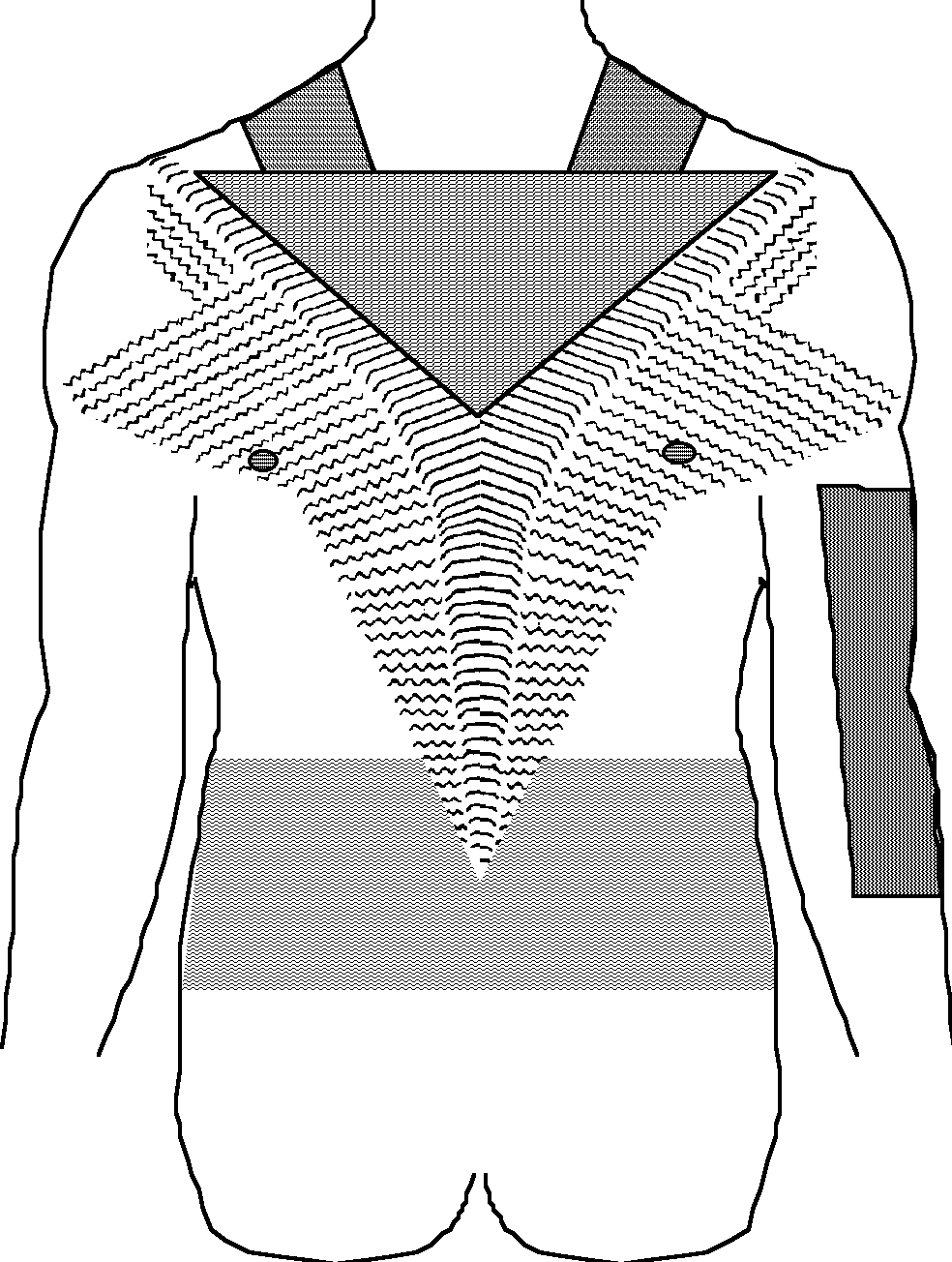
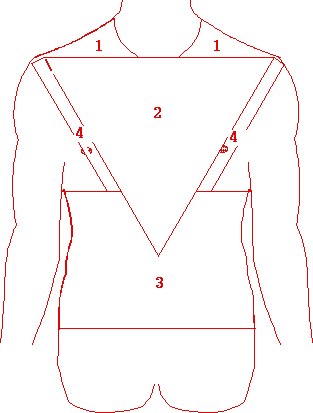
Another kajur fromMile
Hasebe depicts a very unusual chest tattoo, which lacks both the mast and the lower chest triangle (figure 33). Instead, there is a very large upper chest triangle made up of rows of interconnected filled oblique ovals (lijja motif 3a) which are connected with vertical filled ovals (motif 3b). The area which runs out in a point at the navel area, is well defined by a double zigzag border (kein k·m ?, 1). The stomach area is covered with a very wide stomach band which is intersected by the pointed lower parts of the upper chest triangle, consists of horizontal k·do motifs (4a).
The shoulder ornament, which keeps the entire neck and throat area free, shows two zones of oblique zigzags (kein k·m, 1) set in a different orientation.
Back tattooes
Apart from the shoulder zone, the tattoos on the menĽs back consist of three ornament fields, the back triangle and upper back band and the lower back field.
The back triangle (wo eo) [155] is an ornament field defined by a line between the two shoulders and two lines running from the shoulders to a point between the shoulder blades, as far down as the seventh thoracic vertebra. This field is called "ocean" or "sea".[156] Tattooing motifs seen in this ornament field include predominantly zigzag motifs (kein k·m motif No 1). According to informants to Hasebe the tattoos of the commoners had single lines, while those of the chiefs had compound lines, making the tattoo more prominent. [157]
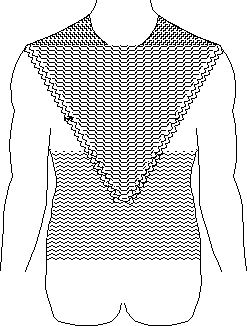
This back triangle is often bordered by two or three parellel executed zigzag lines running at right angles to the main fill of the field. [159]
The upper back band (eotelap) [160] is a horizontal band of varying width, running below the back triangle. It runs from the arm pit to the arm pit. The width of the band has been described as "one hand spa".[161] The tattoo motifs are horizontal, but aligned in such a manner that they form vertical groups, referred to as posts (joor). [162] These vertical groups are well defined and laid out symmetrically. From the spine going to the side, Marshallese distinguished between two "spine posts" (joor in dilep) [163] two "back posts" (joor in limolik) [164] and three "front posts" (joor in limoar). [165] The explanation for the individual terms thus could point to parts of chiefly or meeting house. On the other hand, the upper back band is said to represent the sea.[166] In view of this an entirely different interpretation is possible, based on joor in dilep which is also a used term for a wave feature in Marshallese navigation. [167] While the spine posts are the central wave reflected from the island, the other two posts are the waves reflected from the ocean and the lagoon side of the island. [168]
Hasebe counted eleven vertical groups (posts) on the two complete tattoos he could investigate in 1932. These vertical groups consiste of three or four groups of compound horizontal lines connected by oblique lines to the lines of the next outer adjacent column, staggered by one line. Tattooing motifs seen in this ornament field include kein k·m (motif 1a), k·do (motif 4a), tokrak (motif 11), and kĽdikdik (motif 23a).
The lower back field (tokrak) [169] is bordered by the upper back band at its top and the beginning of the os sacrum at the bottom. Tattooing motifs seen in this ornament field are almost exclusively kein k·m (motif 1a), k·do (motif 4a) and jikin uwe (?) (motif 28). [170]
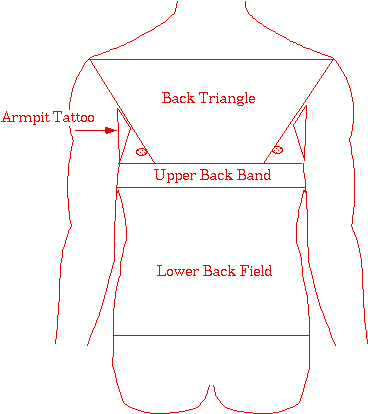
Description of selected back and shoulder tattoos
In the following a selection of complete back and shoulder tattoos, which have been recorded in the past, will be described. For the following tattoo we also have the chest tattoo on record (figure 26).
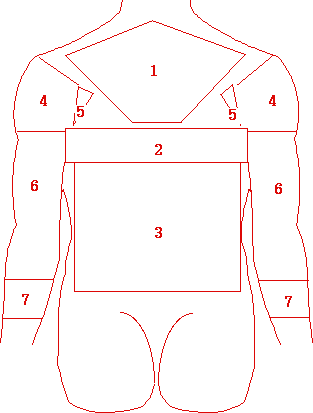
Irooj of Jaluit
The back tattoo of ,Kabua, irooj laplap of Jaluit and most of the Ralik Chain, consists of the upper back triangle, the upper back band and the lower back field, as well as an armpit tattoo and the tattooing of the arms.
The lower back field consists of the complex tokrak motif (24c). The field covers the entire back from the last thoracic vertebrae to the beginning of the os sacrum area. The upper thorarcic area is covered with the upper back band, consisting of ten sets of double lines (eo) arranged in vertical groups. On both sides of the spine is a short group, the joor in dilep, parallel to which are two groups of short strokes, the joor in limolik. On the outside are three vertical groups of wider lines, the joor in limoar. This upper back band goes around the torso and is tattooed partially under the arms. Above the upper back is the upper back triangle, which consists of oblique zigzag lines (kein k·m ?, 1). The sides of the triangle reach the shoulder at the end of the end of the clavicle. This line runs parallel to the upper boundary of the upper arm ornament, which begins at the shoulder blade pit and runs to the shoulder joint. A small triangular ornament field exists between the upper back triangle and the upper back band: the armpit attoo. This ornament field, which in its pointed lower end begins at the arm pit, extends upward to the shoulder blade and acts as a prolongation of the ornamanet field of the upper arm tattoo. It is covered with zigzag lines.

The upper arm areas are covered with horizontally arranged looj motifs (13), with the prongs pointing downwards. The upper arm area ranges from the above mentioned line, shoulderblade to shoulder joint, to the lower end of the deltoid muscle. The area from the lower end of the deltoid to the midle of the lower arm is covered with vertically arranged looj motifs, with their prongs pointing towards the body. The lower arm area from the middle of the lower arm to the wrist is covered with el·żwa motifs (5), which are suspended from the middle arm ornaments.
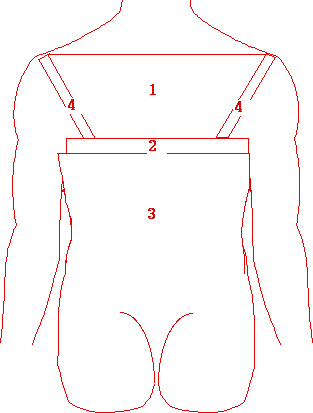
Kajur from Mile
In the 1930s Hasebe reproduced the back tattoo of a man from Mile. Here the lower back field was ornamented with vertically arranged thick zigzag lines (kein k·m, 1) while the upper back band was made up from single, horizontal zigzag lines (kein k·m?, 1). The upper back triangle was covered with oblique zigzag lines and bordered with four sets of long zizgzag lines (kein k·m) running from the shoulder joint to the upper lumbar region.
If this tattoo is correctly rendered, then the motif and ornament field arrangement for this tattoo, as well as the underlying spiritual reasoning differs substantially from that used for KabuaĽs back tattoo. In view of the sparsity of known back tattoo arrangements, we cannot conclude whether this difference is due to a difference in the individualĽs rank, or whether the Mile tattoo is a mere corruption of the traditional lay-out, brought about by time and lack of tattooing practices.
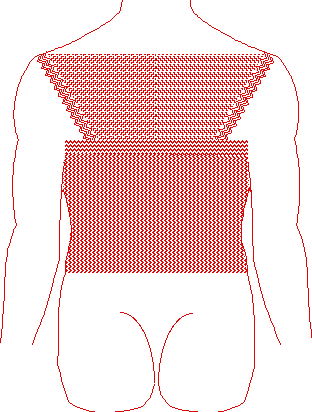
While the chest, back and shoulder tatoos common among men, neck and head tattoos were restricted to males of chiefly rank. [173] The neck tattoo (eooten-boro) [174] consists of horizontal bands running around the neck, leaving only the area of the Adam's apple free. [175] Above the level of the lower jaw, this tattoo continues at the back of the neck all the way up to the hairline, but ends at the ears, to make space for the face tattoo (figure 41). This tattoo has the meaning of a a magic necklace. [176]
The face tattoo (eoon-maj) [177] consists of vertical lines running from the eyes to the rim of the lower jaw. In the front these lines can also extend onto part of the neck. Forehead, face and chin are commonly free of any tattooing. Often, the frontal parts are the cheeks are also left unornamented. [178]

A photograph of irooj laplap ,Murjel of Maloelap taken in 1887 shows him clothed in European dress. Yet both the extended earlobes and the neck and cheek tattoo, similar to that shown in figure 40 are clearly visible. [179] The photograph does not show any tattooed lines in the face or the forehead itself, thus confirming Kr€merĽs assertion. Hasebe (1932), however, depicts a drawing of the face of irooj ,Moses of Aur Atoll, [180] which shows both tattoo marks on neck and cheek, but also lines on the chin and across the face (figure 41).
A British visitor to the Marshall Islands in the 1870s, not a resident or trader of this part of the world, made the following, pertinent comment:
"In one of these canoes there was another king; and I find that the chiefs may always be distinguished from the common people by their being tattooed in parallel blue stripes from the base of the ear to the chin."[181]
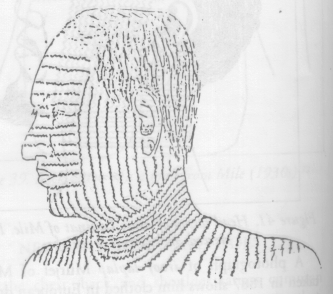
Arm Tattoos
The tattooing of the arms is extremely variable. It can consist of a few lines and in its full extent can reach from the armpits to the wrists. A full tattoo is traditionally divided into three main areas, the area of the upper arm, the area area of the lower arm and the central part in between. Unlike in other areas, the inside of the arms was commonly not tattooed in the Marshallese tattoos.
The area of the upper arm[183] covering the deltoid muscle, is bordered by a line drawn between the armpit and the shoulder (onset of the caput humeris), while the lower border is less well defined, but often matches the upper margin of the upper back band. The tattoo motifs are commonly horizontal and aligned in vertical groups which emphasise the outline of the arm. Tattooing motifs seen in this ornament field include kein k·m (motif 1a), and k·do (motif 4a). On one occasion documented the entire area of the upper arm had been ornamented with a tattoo. The motif used was the looj (motif 13), which was arranged in densely set rows of horizontally aligned motifs.
The area of the lower arm extends about halfway between the elbow and the wrist to the wrists itself. Tattoo motifs are arranged vertically and are aligned in small horizontal groups, giving the arm a ringed appearance. Tattooing motifs seen in this ornament field include kein k·m (motif 1a), pako (motif 21b), and wun (motif 27).
The central part in between is commonly left blank. In the few instances where a tatoo is known, such as the tattoo of Kabua, the entire ornament zone is covered with densely set, vertically alingned looj motifs (motif 13).
Very common was the tattooing of only a couple of bands around the upper arm. [184] These bands, mainly using horizontal zigzag lines (kein k·m, motif 1a), go all around the arm in the form of a bracelet (lukwo or rojażpe). [185] HasebeĽs 1930 census of 238 men showed 56 to be tattooed with indigenous motifs. Of these the overwhelming majority (48) had only horizontal bands around their arms, as well as their legs.
Leg Tattoos
Leg tattoos (wunne) [186] are commonly restricted to the front and the middle of the outside of the upper thigh (figure 42). [187] Tattooing motifs seen in this ornament field include vertically aligned zigzag lines (kein k·m ? motif 1) and the otherwise quite rare motifs 22a and 22b, said to symbolise "spirally peeled sticks" or "intertwined slingplants", both symbols of sexual intercourse. [188] Most leg tattooes, however, are restricted to a few double lines or bands of the wavy-line (k·do motif 4) or zigzag motif (kein k·m motif 1) on their thighs and their calfs.
Other Tattoos
In addition to the main tattoos mentioned, men were sometimes tattooed next to the armpits, the buttocks, and the penis.
The buttock tattoo[189] consists of a rectangular band which covers the lower os sacrum area and the occasionally the side of the buttocks. Tattooing motifs seen in this ornament field include turtle shell motif (bod motif 19), which can sometimes extend to the hip. Close to the thighs the otherwise quite rare motifs 22a and 22b can also be found. [190]
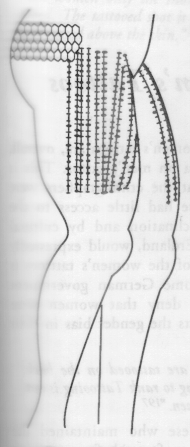
The tattoo next to the armpit[192] was executed on the person's back. It was a small triangle with the base pointing upwards and the tip pointing towards the side. This tattoo, which was very rare even at the end of last century, was primarily a chiefly tattoo, but may have been permitted for other men as well. [193] This ornament field was recorded as seen once and was ornamented with zigzag lines (kein k·m, 1).
A further tattoo, apparently also confined to men of chiefly rank, was the tattooing of the penis including the glans. No details on motifs used or the frequency of occurrence are known.
It has been pointed out by some scholars[194] that the areas mainly covered by tattooes are those which are not covered with clothing. This seems to be borne out by the evidence compiled. Thus in the case of Marshallese men, the main dress to be worn would have left the upper body and arms, as well as the sides of the thighs and possibly parts of the buttocks (when squatting) exposed. These were the areas which were tattooed. [195]
![]()
| select from the following... | ||||||
|
|
||||||
|
Digital Micronesia-An
Electronic
Library & Archive
is provided free of charge
as an advertising-free
information service
for the world community. It is being maintained by Dirk
HR Spennemann, Associate
Professor in Cultural
Heritage Management,Institute of Land, Water and Society and
School
of Environmental & Information Sciences, Charles
Sturt University,
Albury, Australia. The server
space and technical support are provided by Charles
Sturt University as part of its commitment
to regional engagement. Environmental
SciencesInformation
Sciences
|
||||||